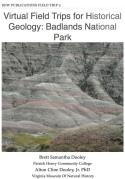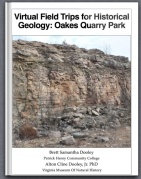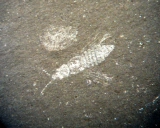 In Part 1, we saw that the Black Hills are surrounded by the Red Valley, which gains its color from the Triassic Spearfish Formation. The outer wall of the Red Valley is made of Jurassic and Cretaceous sediments. But what if we cross the inner rim of the valley, and head toward the middle of the Black Hills? Even at a glance from the highway, it appears that sedimentary layers are dipping away from the Black Hills (above), so we might expect to see a variety of older units. Several roads lead into the core of the mountains, including US 85, which runs south from I-90 toward the town of Deadwood.
In Part 1, we saw that the Black Hills are surrounded by the Red Valley, which gains its color from the Triassic Spearfish Formation. The outer wall of the Red Valley is made of Jurassic and Cretaceous sediments. But what if we cross the inner rim of the valley, and head toward the middle of the Black Hills? Even at a glance from the highway, it appears that sedimentary layers are dipping away from the Black Hills (above), so we might expect to see a variety of older units. Several roads lead into the core of the mountains, including US 85, which runs south from I-90 toward the town of Deadwood.
A short distance from the highway, it quickly becomes clear that we’ve left the Spearfish Formation behind, as we pass into two Permian units, the Minnekahta Limestone and the underlying Opeche Shale:
The Minnekahta includes apparent algal beds (below), while the purple-red color of the Opeche suggests at least some soil development.
A little further south we encounter the Pennsylvanian Minnelusa Formation, a thick unit that’s difficult to describe because, as one geologist told me, “It looks like everything.” In fact, here’s the USGS description:
“Variegated, yellow to red, gray to brown, pink to purple, and black, interbedded sandstone, siltstone, shale, limestone, dolomite, calcarenite, chert and brecciated beds.”
I guess there are a few colors they don’t mention, and one or two lithologies, but that’s a pretty good description of sedimentary rocks in general. Here’s an example:
As we continue south, we get to progressively older units: the Mississippian Pahasapa Limestone, the Devonian Englewood Formation, and the Ordovician Whitewood Limestone and Winnipeg Formation. Below you can see three of these units (this is actually on US 14, a few hundred meters from US 85): the Pahasapa forms the cap at the top of the hill, the partially vegetated rubble in the middle of the hill is the Englewood, and the vertical bluff at the bottom is the Whitewood:
These units have their own distinctive characteristics. The Pahasapa is a thick, resistant layer that caps many of the ridges in the Black Hills. The Pahasapa is also a karst unit, with lots of cavities that are the result of the dissolution of limestone:
The Englewood is a thin, poorly-exposed shale that is actually absent in some areas, while Silurian Period rocks are entirely missing in South Dakota. The underlying Whitewood has a typical array of Ordovician fossils, including tabulate corals and brachiopods:
As we arrive in Deadwood, the impressive Deadwood Formation comes into view, with the type section towering over the town:
The Deadwood is mostly a sandstone, with lots of cross-bedding through much of its thickness:
The upper part is heavily bioturbated, with a variety of different types of trace fossils, including some attributed to trilobites (the lower image below from SDSM includes a probable trilobite trace):
Some beds also contain shell material, especially phosphatic shells such as those from inarticulate brachiopods (such as the example below from the VMNH collection):
In the town of Deadwood there are exposures that show the very bottom of its namesake formation:
Brett’s excited about this boundary because, not only is it the eon boundary between the Proterozoic and Phanerozoic Eons, but it’s also an angular unconformity. If you look closely at the underlying Proterozoic rocks, you can see that they’re bedded, and they’re standing almost on end.
The drive south from I-90 to Deadwood took us through the entire Paleozoic Era section, but the straight line distance on this drive is only about 11 km. Yet the Black Hills are about 160 km on the long axis, so we’re still a long way from the core of the mountains. In Part 3, we’ll move further into the Black Hills to see what rocks are found there.






















Great post, lovely photos, but I have a minor quibble. The unconformity in the last photo is technically a nonconformity, not an angular unconformity, presuming those are metamorphic rocks on the bottom.
I think you’re technically correct, as the rocks are indeed metamorphic by most any definition. However, they are metasediments, and the tilted layers in this case are original bedding, so the principles at play in an angular unconformity still hold.
To follow up on Ron’s comment, for readers who may not be familiar with the technical terms: unconformities are surfaces within rocks that represent missing time, either through erosion or non-deposition. There are, of course, several subcategories:
Disconformities are unconformities between parallel sedimentary layers, typically with an erosional surface on the top of the older unit. These are what we get between the units at Carmel Church. If there’s no erosion on the surface, these are sometimes referred to as paraconformities.
An angular unconformity occurs if sedimentary layers are deposited on top of older layers that were first tilted and eroded. That means the younger beds will be cutting off the older beds at an angle.
A nonconformity occurs when sedimentary rocks are deposited on an erosional surface cut into igneous or metamorphic rocks.
In this case, the ambiguity occurs because the older rocks are definitely metamorphosed (making this a nonconformity), but they still retain the original bedding (making it an angular unconformity).
Butch
I have only worked with Robert Weems helping excavate a devonian hard rock limestone to take out large blocks of a devonian atrhrodire brothrolepis virginicanus and came lose to having a 500 lb slab skock me down but thanks to youth and agility that did not happen. Dave Bohaska and I were in contact a few days ago and asked me if the P street dump in Richmond was still intact. I told him I would contact you and maybe you could inform me of the situation. I told him if he wants to go down there I willl be carrying a piece since the neighborhood around the area is run by slugs and juvenile devients. He joked with me and said is this your paranoia and said oh no boss man it was because in the overseas positions with the public health service and doing work for a few agencies you always assessed the risk